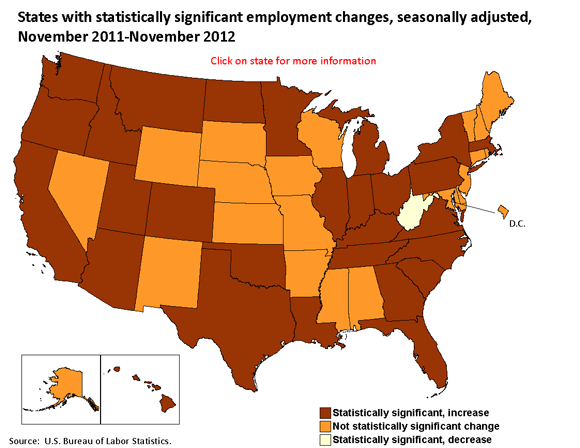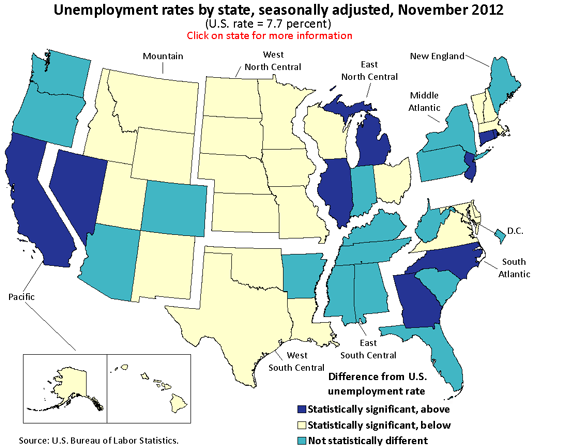An official website of the United States government
 United States Department of Labor
United States Department of Labor
From November 2011 to November 2012, nonfarm employment increased in 45 states and decreased in 5 states and the District of Columbia. The largest over-the-year percentage increase occurred in North Dakota (+4.7 percent); the largest decrease occurred in West Virginia (−1.8 percent).
Over the year, 29 states experienced statistically significant changes in employment; only West Virginia’s employment decreased (−1.8 percent, or −13,800). Among those states, North Dakota recorded the largest over-the-year percentage increase in employment (+4.7 percent, or +18,800), followed by Utah (+3.1 percent, or +38,200) and Hawaii (+3.0 percent, or +17,700).

| State | Percent change in nonfarm employment from November 2011 to November 2012(p) | Statistical significance |
|---|---|---|
Alabama | 0.8 | Not statistically significant change |
Alaska | -0.3 | Not statistically significant change |
Arizona | 2.5 | Statistically significant, increase |
Arkansas | 1.0 | Not statistically significant change |
California | 1.9 | Statistically significant, increase |
Colorado | 2.3 | Statistically significant, increase |
Connecticut | 0.1 | Not statistically significant change |
Delaware | 0.2 | Not statistically significant change |
District of Columbia | -0.4 | Not statistically significant change |
Florida | 1.1 | Statistically significant, increase |
Georgia | 1.7 | Statistically significant, increase |
Hawaii | 3.0 | Statistically significant, increase |
Idaho | 2.1 | Statistically significant, increase |
Illinois | 0.9 | Statistically significant, increase |
Indiana | 2.1 | Statistically significant, increase |
Iowa | 0.8 | Not statistically significant change |
Kansas | 0.4 | Not statistically significant change |
Kentucky | 2.1 | Statistically significant, increase |
Louisiana | 2.1 | Statistically significant, increase |
Maine | 0.1 | Not statistically significant change |
Maryland | 0.6 | Not statistically significant change |
Massachusetts | 1.5 | Statistically significant, increase |
Michigan | 0.8 | Statistically significant, increase |
Minnesota | 1.9 | Statistically significant, increase |
Mississippi | 0.1 | Not statistically significant change |
Missouri | 0.7 | Not statistically significant change |
Montana | 2.2 | Statistically significant, increase |
Nebraska | 0.7 | Not statistically significant change |
Nevada | 1.2 | Not statistically significant change |
New Hampshire | -0.3 | Not statistically significant change |
New Jersey | 0.6 | Not statistically significant change |
New Mexico | -0.7 | Not statistically significant change |
New York | 1.0 | Statistically significant, increase |
North Carolina | 1.5 | Statistically significant, increase |
North Dakota | 4.7 | Statistically significant, increase |
Ohio | 2.0 | Statistically significant, increase |
Oklahoma | 2.4 | Statistically significant, increase |
Oregon | 1.2 | Statistically significant, increase |
Pennsylvania | 0.8 | Statistically significant, increase |
Rhode Island | -0.5 | Not statistically significant change |
South Carolina | 1.9 | Statistically significant, increase |
South Dakota | 0.7 | Not statistically significant change |
Tennessee | 1.0 | Statistically significant, increase |
Texas | 2.6 | Statistically significant, increase |
Utah | 3.1 | Statistically significant, increase |
Vermont | 0.9 | Not statistically significant change |
Virginia | 1.3 | Statistically significant, increase |
Washington | 1.7 | Statistically significant, increase |
West Virginia | -1.8 | Statistically significant, decrease |
Wisconsin | 0.5 | Not statistically significant change |
Wyoming | 0.5 | Not statistically significant change |
Footnotes: | ||
In November 2012, twenty-five states reported jobless rates significantly lower than the U.S. figure of 7.7 percent, 9 states had measurably higher rates, and 16 states and the District of Columbia had rates that were not appreciably different from that of the nation.

| State | Unemployment rate (p) | Difference from U.S. rate |
|---|---|---|
Alabama | 7.5 | Not statistically different |
Alaska | 6.8 | Statistically significant, below |
Arizona | 7.8 | Not statistically different |
Arkansas | 7.0 | Not statistically different |
California | 9.8 | Statistically significant, above |
Colorado | 7.7 | Not statistically different |
Connecticut | 8.8 | Statistically significant, above |
Delaware | 6.7 | Statistically significant, below |
District of Columbia | 8.4 | Not statistically different |
Florida | 8.1 | Not statistically different |
Georgia | 8.5 | Statistically significant, above |
Hawaii | 5.3 | Statistically significant, below |
Idaho | 6.8 | Statistically significant, below |
Illinois | 8.7 | Statistically significant, above |
Indiana | 8.0 | Not statistically different |
Iowa | 4.9 | Statistically significant, below |
Kansas | 5.4 | Statistically significant, below |
Kentucky | 8.2 | Not statistically different |
Louisiana | 5.8 | Statistically significant, below |
Maine | 7.2 | Not statistically different |
Maryland | 6.6 | Statistically significant, below |
Massachusetts | 6.6 | Statistically significant, below |
Michigan | 8.9 | Statistically significant, above |
Minnesota | 5.7 | Statistically significant, below |
Mississippi | 8.5 | Not statistically different |
Missouri | 6.7 | Statistically significant, below |
Montana | 5.8 | Statistically significant, below |
Nebraska | 3.7 | Statistically significant, below |
Nevada | 10.8 | Statistically significant, above |
New Hampshire | 5.6 | Statistically significant, below |
New Jersey | 9.6 | Statistically significant, above |
New Mexico | 6.2 | Statistically significant, below |
New York | 8.3 | Not statistically different |
North Carolina | 9.1 | Statistically significant, above |
North Dakota | 3.1 | Statistically significant, below |
Ohio | 6.8 | Statistically significant, below |
Oklahoma | 5.2 | Statistically significant, below |
Oregon | 8.4 | Not statistically different |
Pennsylvania | 7.8 | Not statistically different |
Rhode Island | 10.4 | Statistically significant, above |
South Carolina | 8.3 | Not statistically different |
South Dakota | 4.4 | Statistically significant, below |
Tennessee | 7.6 | Not statistically different |
Texas | 6.2 | Statistically significant, below |
Utah | 5.1 | Statistically significant, below |
Vermont | 5.2 | Statistically significant, below |
Virginia | 5.6 | Statistically significant, below |
Washington | 7.8 | Not statistically different |
West Virginia | 7.3 | Not statistically different |
Wisconsin | 6.7 | Statistically significant, below |
Wyoming | 5.1 | Statistically significant, below |
Footnotes: | ||
Nevada continued to record the highest unemployment rate among the states, 10.8 percent in November 2012, followed by Rhode Island at 10.4 percent. North Dakota again registered the lowest jobless rate, 3.1 percent.
From November 2011 to November 2012, twenty-two states and the District of Columbia reported statistically significant unemployment rate changes, all of which were declines. The largest of these occurred in Nevada (−2.4 percentage points), followed by Mississippi (−2.1 points) and Florida (−2.0 points).
These data are from the Current Employment Statistics (State and Metro Area) and Local Area Unemployment Statistics programs. Data for the most recent month are preliminary and subject to revision. To learn more, see "Regional and State Employment and Unemployment — November 2012" (HTML) (PDF), news release USDL-12-2462.
Bureau of Labor Statistics, U.S. Department of Labor, The Economics Daily, State employment and unemployment, November 2012 at https://www.bls.gov/opub/ted/2012/ted_20121231.htm (visited December 14, 2025).

